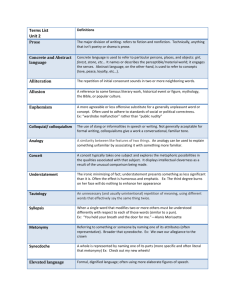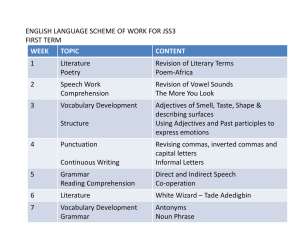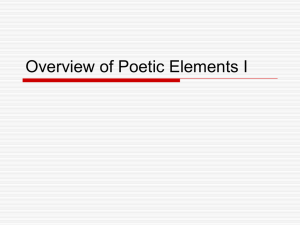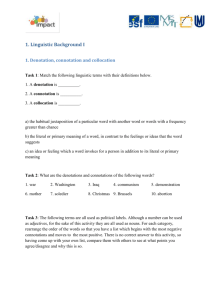Synecdoche&etc - Liberty Union High School District
advertisement
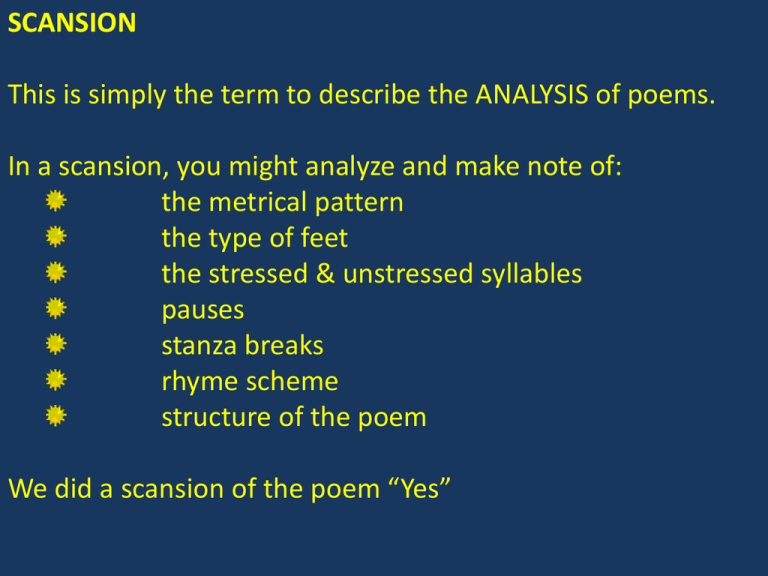
SCANSION This is simply the term to describe the ANALYSIS of poems. In a scansion, you might analyze and make note of: the metrical pattern the type of feet the stressed & unstressed syllables pauses stanza breaks rhyme scheme structure of the poem We did a scansion of the poem “Yes” REFRAIN A part of a poem which is repeated. Example: “O Best of All Nights, Return and Return Again” By James Laughlin APOSTROPHE This is when a poem sounds like it is speaking to someone or something. The poem may address a dead or absent person. It may also address something that is personified. John Donne’s “Death, Be Not Proud” is an example. In it, the poet speaks directly to death. Emily Dickinson addresses a person who is no longer in her life in “Wild nights! – Wild nights!” ABECEDARIAN Related to acrostic, a poem in which the first letter of each line or stanza follows sequentially through the alphabet. Or, a poem which uses the alphabet as its organizational structure. These are usually long poems, but here is a shorter example on the next slide. “A Primer of the Daily Round” by Howard Nemerov A peels an apple, while B kneels to God, C telephones to D, who has a hand On E’s knee, F coughs, G turns up the sod For H’s grave, I do not understand But J is bringing one clay pigeon down While K brings down a nightstick on L’s head, And M takes mustard, N drives to town, O goes to bed with P, and Q drops dead, R lies to S, but happens to be heard By T, who tells U not to fire V For having to give W the word That X is now deceiving Y with Z, Who happens, just now to remember A Peeling an apple somewhere far away. METONYMY A figure of speech – when a word is not used because it is more poetic to use another term which represents that word. For example, instead of saying, “The British Monarchy,” you could use the metonymy “Crown.” In Shakespeare, “lend me your ears” should not be taken literally. “Ears” is a metonymy for “your attention.” “The pen is mightier than the sword.” “Pen” is a metonymy for the written word, and “sword” is a metonymy for the force of the military. SYNECDOCHE A figure of speech – when you use a part of something as a replacement for the actual word. You might call your car your “wheels.” “Wheels” is a synecdoche for vehicle or car. We often say we will give someone a “hand.” “Hand” is a synecdoche for assistance, help, support, applause. “Hand” can also be a synecdoche for a person when it is used, “hired hand.” CAESURA This is a stop or a pause in a line of poetry. It is often marked by some punctuation or by a grammatical boundary. Dead! One of them shot by sea in the east No voice says ‘my mother’ again to me. What? These are lines from Elizabeth Barrett Browning’s long poem “Mother and Poet” END-STOPPED When a line of poetry ends at a grammatical boundary or break. Sometimes a dash, punctuation, a closing parenthesis. Example of end-stopped lines of poetry from Alexander Pope: Then say not man’s imperfect, Heav’n in fault; Say rather, man’s as perfect as he ought: His knowledge measur’d to his state and place, His time a moment, and a point his space. If to be perfect in a certain sphere, What matter, soon or late, or here or there? The blest today is as completely so, As who began a thousand years ago. ENJAMBMENT This is the opposite of end-stopped. Enjambed lines continue and cross-over from one line to the next, as in this example: the back wings of the hospital where nothing will grow lie cinders in which shine the broken pieces of a green bottle



